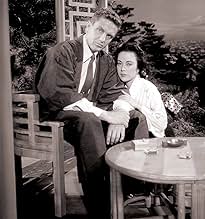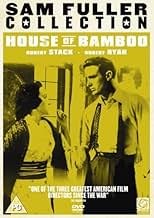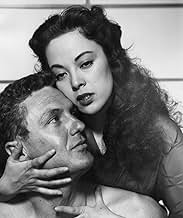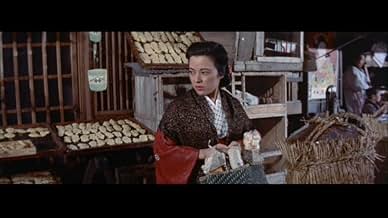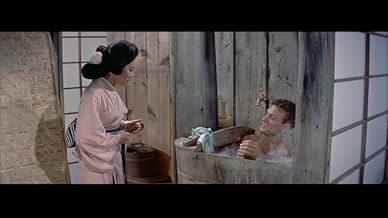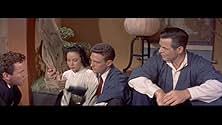IMDb RATING
6.8/10
4.3K
YOUR RATING
Planted in a Tokyo crime syndicate, a U.S. Army Investigator attempts to probe the coinciding death of a fellow Army official.Planted in a Tokyo crime syndicate, a U.S. Army Investigator attempts to probe the coinciding death of a fellow Army official.Planted in a Tokyo crime syndicate, a U.S. Army Investigator attempts to probe the coinciding death of a fellow Army official.
Clifford Arashiro
- Policeman
- (uncredited)
Sandy Azeka
- Charlie's Girl at Party
- (uncredited)
Harry Carey Jr.
- John
- (uncredited)
Barry Coe
- Captain Hanson's Aide
- (uncredited)
John Doucette
- Skipper
- (uncredited)
Fuji
- Pachinko Manager
- (uncredited)
Samuel Fuller
- Japanese policeman
- (uncredited)
Peter Gray
- Willy
- (uncredited)
- Director
- Writers
- All cast & crew
- Production, box office & more at IMDbPro
Storyline
Did you know
- TriviaAccording to Robert Stack, Samuel Fuller told an actor to go down really low when he passed a 50-gallon drum. Without informing the actor, the director had a sharpshooter on a parallel who shot over the man's head and into the drum. After it blew up, the actor said, "Jesus Christ! Those were real bullets!" Fuller laconically replied, "Don't worry. He knew what he was doing."
- GoofsSandy fires an awful lot of shots from his pistol (which is a revolver) without ever appearing to reload it.
- Quotes
Sandy Dawson: Who are you working for?
Eddie Kenner: [posing as Eddie Spanier] Spanier.
Sandy Dawson: Who's Spanier?
Eddie Kenner: Me.
Sandy Dawson: Who else you working for?
Eddie Kenner: Eddie.
- ConnectionsEdited into Shock Corridor (1963)
Featured review
This movie has similarities to THE THIRD MAN in that both involve someone (an American) living comfortably in an alien culture as a parasitic gangster in a war ravaged country just after WW2 with a good guy (another American) in pursuit. In narrow cinematic terms, in terms of the story as other reviewers point out, its not a great movie. There is though very much more of interest to it than that.
In historical terms we see Tokyo as it then was in 1954. We see the Japanese as officials, as policemen, as gangsters, the good, the bad, in their natural habitat rather than simply as massed cruel soldiery or suicidal pilots. It has elements of a travelogue with a fascinating glimpse behind the rice paper screen. The movie, which has really handsome colour photography, starts with the curious beauty of a snow covered landscape with Mount Fuji in the background and a murderous attack on a military supply train in the foreground. The ending too shares the same deliberate disjunction - dark violent justice dealt out in a sunny family setting - Top of the World, Ma?
Robert Stack here very much pre-figures his role as Eliot Ness in THE UNTOUCHABLES - dogged and brave in the fight against organised crime. Robert Ryan, tall impeccably elegant and seemingly entirely at ease as a violent mobster in a very foreign land.
Much criticism seems carping and misses the point. As was said of the dog that could walk upright - the question was not so much that he couldn't do it perfectly but that he could do it at all. This was a unique bold movie embedded in post WW2 underworld Japan really striving for authenticity. Not the customary montage of tourist sites and hotel interiors with a cast looking as if they'd gone no further than that themselves.
Were there American gangsters in this way in post war Japan? Presumably so if CATCH 22 is any guide. In this movie however the morality is old-fashioned, certain and unambiguous. By 1970 CATCH 22 served up satire and moral ambiguity to the Hippy generation.
A fascinating little bit of history as well as being a very watchable movie
In historical terms we see Tokyo as it then was in 1954. We see the Japanese as officials, as policemen, as gangsters, the good, the bad, in their natural habitat rather than simply as massed cruel soldiery or suicidal pilots. It has elements of a travelogue with a fascinating glimpse behind the rice paper screen. The movie, which has really handsome colour photography, starts with the curious beauty of a snow covered landscape with Mount Fuji in the background and a murderous attack on a military supply train in the foreground. The ending too shares the same deliberate disjunction - dark violent justice dealt out in a sunny family setting - Top of the World, Ma?
Robert Stack here very much pre-figures his role as Eliot Ness in THE UNTOUCHABLES - dogged and brave in the fight against organised crime. Robert Ryan, tall impeccably elegant and seemingly entirely at ease as a violent mobster in a very foreign land.
Much criticism seems carping and misses the point. As was said of the dog that could walk upright - the question was not so much that he couldn't do it perfectly but that he could do it at all. This was a unique bold movie embedded in post WW2 underworld Japan really striving for authenticity. Not the customary montage of tourist sites and hotel interiors with a cast looking as if they'd gone no further than that themselves.
Were there American gangsters in this way in post war Japan? Presumably so if CATCH 22 is any guide. In this movie however the morality is old-fashioned, certain and unambiguous. By 1970 CATCH 22 served up satire and moral ambiguity to the Hippy generation.
A fascinating little bit of history as well as being a very watchable movie
- trimmerb1234
- Oct 9, 2006
- Permalink
- How long is House of Bamboo?Powered by Alexa
Details
- Release date
- Country of origin
- Languages
- Also known as
- The Tokyo Story
- Filming locations
- Tokyo, Japan(rooftop playground of the Matsuma department store)
- Production company
- See more company credits at IMDbPro
Box office
- Budget
- $1,380,000 (estimated)
- Runtime1 hour 42 minutes
- Aspect ratio
- 2.55 : 1
Contribute to this page
Suggest an edit or add missing content





